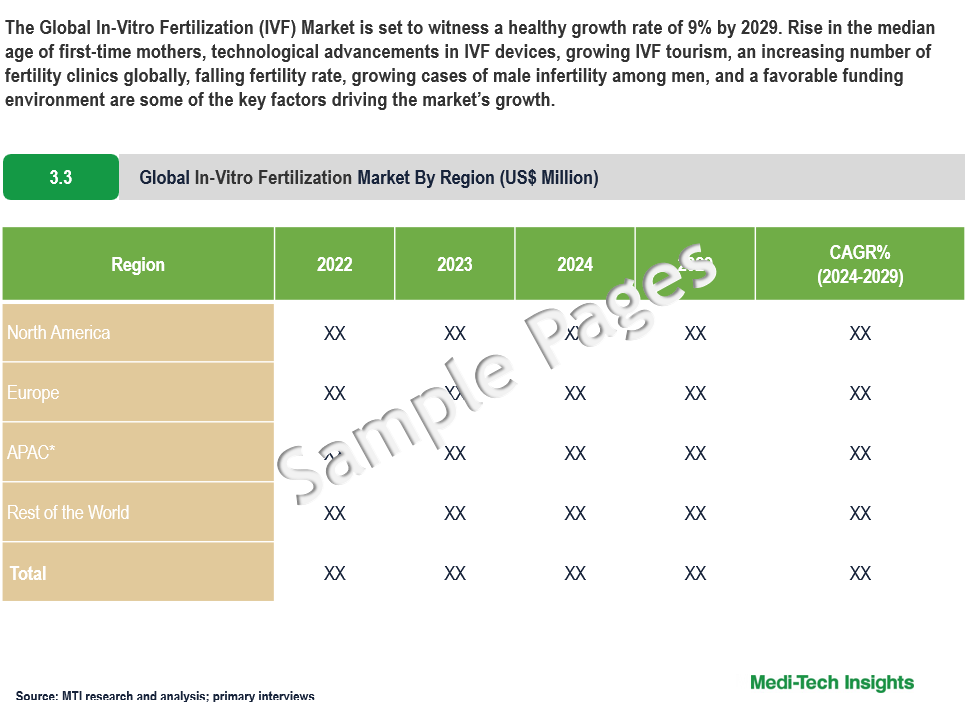
In-Vitro Fertilization (IVF) Market: Global Industry Analysis, Growth Factors, Size, Share, and Revenue For Forecast 2024 to 2029
The Global In-Vitro Fertilization (IVF) Market is set to witness a healthy growth rate of 9% by 2029. Rise in the median age of first-time mothers, technological advancements in IVF devices, growing IVF tourism, an increasing number of fertility clinics globally, falling fertility rate, growing cases of male infertility among men, and a favorable funding environment are some of the key factors driving the market’s growth. To learn more about the research report, download a sample report.
In-vitro fertilization (IVF) is a complex and advanced assisted reproductive technology used to help individuals and couples conceive a child. The process involves stimulating a woman's ovaries to produce multiple eggs, retrieving these eggs surgically, and fertilizing them with sperm in a laboratory setting. The resulting embryos are then cultured for a few days before being transferred into the woman's uterus with the hope of achieving a successful pregnancy. IVF is often utilized to overcome various fertility issues, including blocked fallopian tubes, male infertility, and genetic disorders.
COVID-19 Impact on the In-Vitro Fertilization Market
Throughout 2020 and 2021, the COVID-19 virus spread rapidly and relentlessly across the globe and adversely impacted a multitude of industries worldwide. With lockdowns implemented, social distancing mandated, and widespread apprehension – COVID-19 adversely impacted health services internationally and the IVF industry was no different.
The news of the outbreak of the Covid-19 virus adversely impacted the IVF market in terms of the number of treatments and fertility services as IVF clinics had to shut down their businesses to reduce the spread of the virus. The virus also halted IVF tourism in several cost-effective destinations. However, the global IVF market is now in a recovery phase due to the efforts of IVF clinics to meet the pent-up need that was caused by the cancelled treatments.
The COVID-19 pandemic paved the way for digital adoption in the IVF sector to gain operational efficiency and telehealth adoption to survive and thrive in unprecedented times. To overcome the challenges caused by the virus, IVF clinics have cross-trained their staff and replaced physical patient interactions with digital communication. To resume operations, IVF clinics are now stringently following Covid-safety protocols and in-person consultations are fast being replaced with online consultations. IVF clinics are further expected to embrace the new-age model of online consultations and video consultations are likely to be the new norm in the IVF sector.
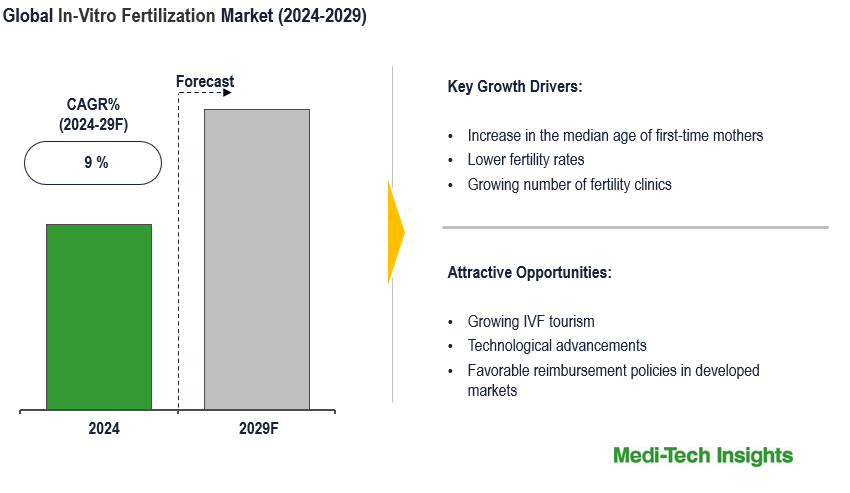
To learn more about this report, download the PDF brochure
Technological Advancements in IVF Devices Drive the In-Vitro Fertilization Market
The IVF market comprises an array of equipment, reagents & media, accessories, and technologies that continue to witness technological advancements. For instance,
- In June 2022, FUJIFILM Irvine Scientific, Inc. announced its exclusive licensing of AI-based technology for image-based evaluation of human embryos, developed and patented by experts from Brigham and Women’s Hospital and Massachusetts General Hospital, to enhance IVF success rates
- In May 2022, Cook Medical launched MINC+™ Benchtop Incubator for clinical embryologists and IVF clinics in the US and Canada. The MINC+ is the next generation of the MINC® Mini Incubator, a benchtop incubator that has been a standard component in IVF clinics for more than 20 years
- In December 2021, Multiply, a US-based startup launched its AI-based platform that is likely to replace conventional processes in IVF clinics. Multiply makes it easy to enter and organize data about the patients, their treatments, the tests performed, equipment used, and also to manage appointments, schedules, and inventory. It consolidates data from various sources in an IVF clinic such as labs, operating rooms, consulting rooms, registration desks and organizes it in an easily accessible, and secure manner
Growing IVF Tourism Boosts the In-Vitro Fertilization Market
In recent years, there has been a growing trend toward IVF tourism. It is a type of medical tourism in which patients travel to other states or countries seeking fertility treatments in various forms. India, Spain, Czech Republic, Greece, Turkey, and Denmark have emerged as top IVF destinations. The key reasons why people travel abroad for IVF treatments are:
- Relatively lower cost of the treatment in another country
- Availability of well-equipped IVF clinics with high-class infrastructures and skilled professionals
- Expertise in handling almost all kinds of treatment and diagnostic methods of IVF including ICSI, IUI, egg donation, embryo transfer and endoscopic diagnosis
- The treatments are not legally available in the home country or availability is limited
- Long waiting lists
- The treatment is not available for some types of patients (gays, lesbians, single people, and members of certain religions) by the law of the home country
- Greater donor options in another country
- Availability of better options for control over fertilization results
- For example, the US allows pre-implantation genetic diagnosis (PGD) of in vitro fertilization embryos. It gives couples the option to pick and choose which embryos will be implanted in the uterus based on genetic factors (including chromosomal deficiencies and sex).
- PGD used for sex selection is illegal in some other countries that offer in vitro fertilization
- Specific countries can provide the desired genealogy.
“IVF tourism is a key factor driving the IVF market. The growing prominence of lesser-known destinations such as Grand Cayman Island and Barbados due to favourable regulations, low treatment cost, and availability of PGD (pre-implantation genetic diagnosis) is a pivotal contributing factor propelling it’s the IVF market.” - Director, Leading IVF Equipment Manufacturer, United States
Product Segment Analysis
The global in-vitro fertilization (IVF) market is segmented into three primary product categories: equipment, reagents and media, and accessories. The equipment segment, which includes devices such as incubators, imaging systems, and micromanipulation systems, holds a significant share due to the essential role these advanced tools play in the IVF process. Reagents and media, comprising culture media, cryopreservation media, and other consumables, are crucial for the successful fertilization and development of embryos, thus commanding a substantial portion of the market. Lastly, the accessories segment, which includes catheters, needles, and slides, complements the primary equipment and reagents by ensuring the smooth execution of IVF procedures. Together, these segments drive the growth and innovation in the IVF market, meeting the increasing demand for fertility treatments worldwide.
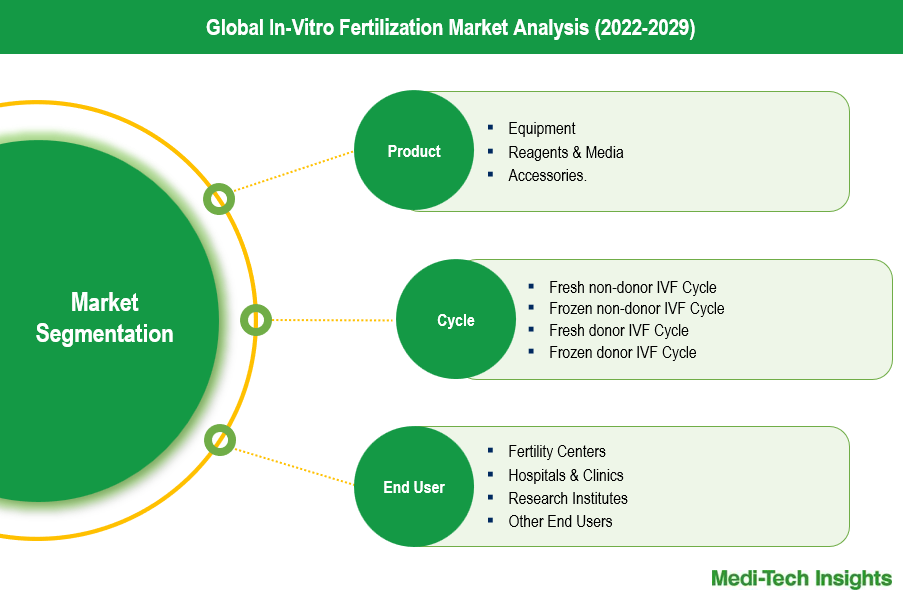
To learn more about this report, download the PDF brochure
End-User Segment Analysis
The global in vitro fertilization (IVF) market is categorized into three primary end-user segments: hospitals, clinics, and fertility centers. Among these, hospitals hold the largest market share. This leading position can be attributed to several factors. Firstly, the availability of IVF services in hospitals has been steadily increasing, providing patients with more accessible options for treatment. Additionally, hospitals are often perceived as more reliable and equipped with advanced medical technologies and comprehensive healthcare facilities, which attract a larger number of patients seeking IVF treatment.
Clinics and fertility centers follow hospitals in market share, but they are also experiencing growth due to the specialized care and personalized treatment plans they offer. Clinics often provide a more intimate setting and individualized attention, which can be appealing to patients. Fertility centers, being dedicated exclusively to reproductive health, bring specialized expertise and advanced techniques that further enhance their appeal. Overall, while hospitals dominate the market due to their widespread availability and perceived reliability, clinics and fertility centers are increasingly preferred for their specialized services and patient-centric approach.
Competitive Landscape Analysis: In-Vitro Fertilization Market
The in-vitro fertilization market is marked by the presence of key players such The Cooper Companies Inc., Vitrolife, Thermo Fisher Scientific, Esco Medical, IVFtech ApS, FUJIFILM Irvine Scientific, Kitazato Corporation, FERTIPRO NV, Gynotec B.V., among others.
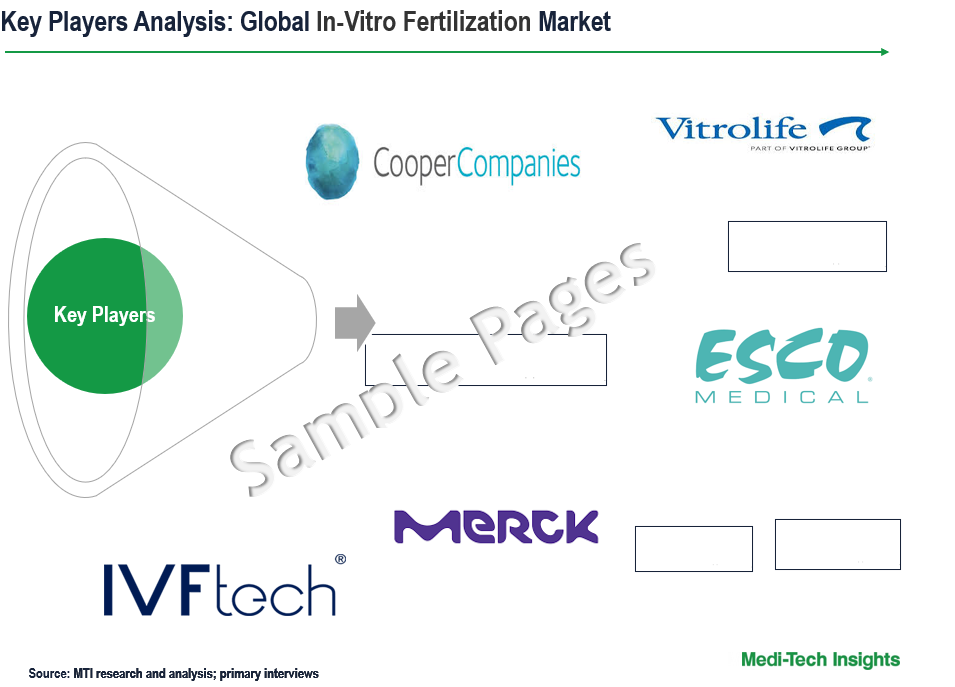
Get a sample report for competitive landscape analysis
Organic and Inorganic Growth Strategies Adopted by Players to Establish Their Foothold in the Market
Players operating in this market are adopting both organic and inorganic growth strategies such as collaborations, acquisitions, and new product launches to garner market share. For instance,
- In May 2024, Vitrolife AB signed an agreement to acquire 100% of the shares in eFertility, marking a strategic move to enhance standardization and digitalization in IVF clinics globally as part of the Vitrolife Group’s broader strategy
- In March 2024, Esco Vietnam participated in the Clinical Embryology Conference (C.E.C), highlighting the importance of collaborative forums in reproductive medicine that promote growth and innovation by sharing advancements and experiences in Assisted Reproductive Technology (ART) and In Vitro Fertilization (IVF) research.
- In October 2023, Merck, a leading science and technology company, will launch a comprehensive Fertility Benefit program providing financial support for fertility treatments to employees in Germany, the UK, Switzerland, China, India, Taiwan, Brazil, and Mexico, expanding similar benefits already available in the US, Canada, and Japan, with further expansions planned for 2024
- In February 2022, CooperCompaniesl entered into an $875 million deal to purchase Cook Medical's reproductive health portfolio, which includes medical devices for fertility, obstetrics, gynaecology, and in vitro fertilization
- In November 2021, CooperCompanies announced a definitive agreement to acquire Generate Life Sciences, a private leader in providing donor eggs and sperm for fertility treatments, fertility cryopreservation services, and newborn stem cell storage (cord blood and cord tissue)
- In January 2021, Asia Healthcare Holdings-owned Nova IVF Fertility, India's leading fertility chain, announced its network expansion by acquiring a majority stake in Southend Fertility & IVF through a strategic partnership.
The outlook for the in-vitro fertilization market looks promising due to constant technological advancements in IVF devices, increasing government initiatives to promote IVF treatments, the emergence of new low-cost IVF tourism destinations, and the growing use of fertility treatment options by single parents and same-sex couples.
| Report Scope | Details |
| Base Year Considered | 2023 |
| Historical Data | 2022 - 2023 |
| Forecast Period | 2024 - 2029 |
| CAGR (2024 - 2029) | 9% |
| Segment Scope | Product, Cycle, End User |
| Regional Scope |
|
| Key Companies Mapped | The Cooper Companies Inc., Vitrolife, Thermo Fisher Scientific, Esco Medical, IVFtech ApS, FUJIFILM Irvine Scientific, Kitazato Corporation, FERTIPRO NV, Gynotec B.V., among others |
| Report Highlights | Market Size & Forecast, Growth Drivers & Restraints, Trends, Competitive Analysis |
Key Strategic Questions Addressed
-
What is the market size & forecast for the Global In-Vitro Fertilization Market?
-
What are the historical, present, and forecasted market shares and growth rates of various segments and sub-segments of the Global In-Vitro Fertilization Market?
-
How has COVID-19 impacted the Global In-Vitro Fertilization Market?
-
What are the major growth drivers, restraints/challenges impacting the market?
-
What are the opportunities prevailing in the market?
-
What is the investment landscape?
-
Which region has the highest share in the global market? Which region is expected to witness the highest growth rate in the next 5 years?
-
Who are the major players operating in the market? What is the competitive positioning of key players?
-
Who are the new players entering the market?
-
What are the key strategies adopted by players?
- Research Methodology
- Secondary Research
- Primary Research
- Market Estimation
- Market Forecasting
- Executive Summary
- Market Overview
- Market Dynamics
- Drivers
- Restraints
- Key Market Trends
- Market Dynamics
-
- Industry Speaks
- Key Revenue Pockets
- Global In-Vitro Fertilization Market - Size & Forecast (2021-2028), By Product
- Equipment’s
- Reagents & Media
- Accessories
- Global In-Vitro Fertilization Market - Size & Forecast (2021-2028), By Cycle
- Fresh non-donor IVF cycle
- Frozen non-donor IVF cycle
- Fresh donor IVF cycle
- Frozen donor IVF cycle
- Global In-Vitro Fertilization Market - Size & Forecast (2021-2028), By End User
- Fertility Centers
- Hospitals & Clinics
- Research Institutes
- Other End Users
- Global In-Vitro Fertilization Market - Size & Forecast (2021-2028), By Region
- North America (U.S. & Canada)
- Europe (UK, Germany, France, Italy, Spain, Rest of Europe)
- Asia Pacific (China, India, Japan, Rest of Asia Pacific)
- Rest of the World (Latin America, Middle East & Africa)
- Competitive Landscape
- Key Players and their Competitive Positioning
- Competitive Positioning of Key Players (2022)
- Offerings Assessment, By Player
- Key Strategies Assessment, By Player (2021-2023)
- New Product & Service Launches
- Partnerships, Agreements, & Collaborations
- Mergers & Acquisitions
- Geographic Expansion
- Key Players and their Competitive Positioning
- Key Companies Scanned (Indicative List)
- The Cooper Companies Inc.
- Vitrolife
- Thermo Fisher Scientific
- Esco Medical
- IVFtech ApS
- FUJIFILM Irvine Scientific
- Kitazato Corporation
- FERTIPRO NV
- Gynotec B.V.
- Other Prominent Players
The study has been compiled based on extensive primary and secondary research.
Secondary Research (Indicative List)
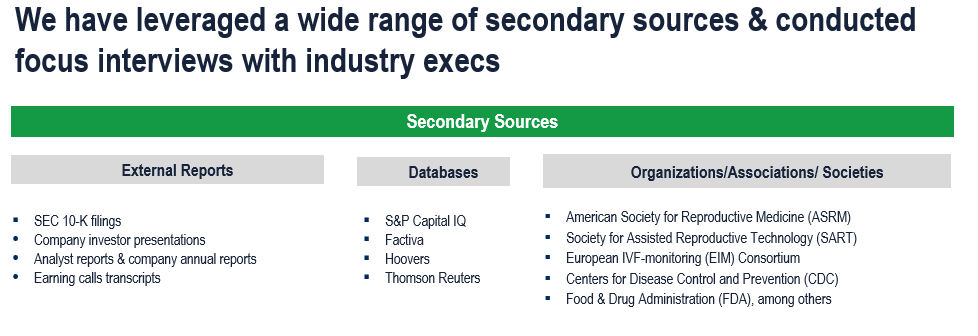
Primary Research
To validate research findings (market size & forecasts, market segmentation, market dynamics, competitive landscape, key industry trends, etc.), extensive primary interviews were conducted with both supply and demand-side stakeholders.
Supply Side Stakeholders:
- Senior Management Level: CEOs, Presidents, Vice-Presidents, Directors, Chief Technology Officers, Chief Commercial Officers
- Mid-Management Level: Product Managers, Sales Managers, Brand Managers, Business Development Managers, Consultants
Demand Side Stakeholders:
- Stakeholders in Fertility Clinics, Hospitals, Research Institutes and Other End Users
Breakdown of Primary Interviews
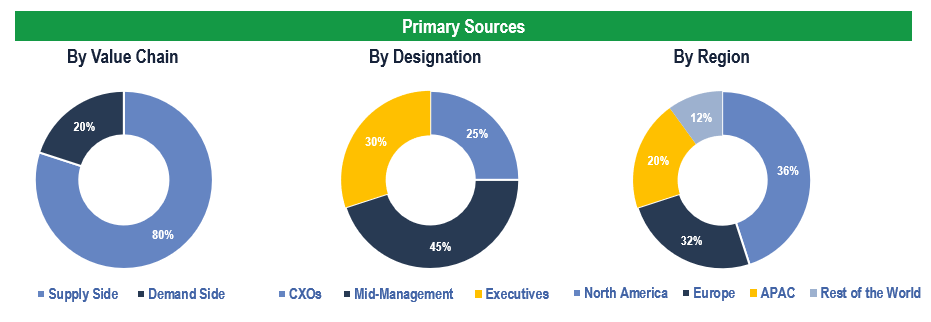
Market Size Estimation
Both ‘Top-Down and Bottom-Up Approaches’ were used to derive market size estimates and forecasts.
Data Triangulation
Research findings derived through secondary sources & internal analysis were validated with Primary Interviews, Internal Knowledge Repository, and Company Sales Data.

